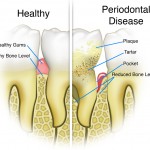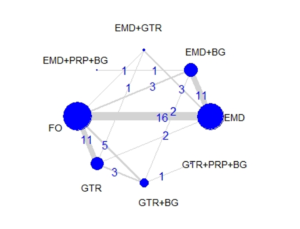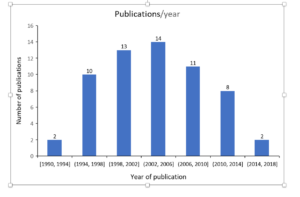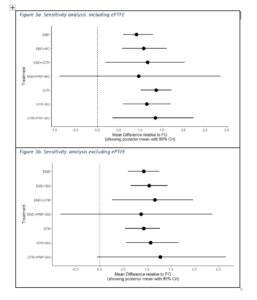
Guided tissue regeneration (GTR) and enamel matrix derivatives (EMD) are two popular regenerative treatments for periodontal infrabony lesions. In 2012 Tu and co-workers undertook a network meta-analysis (NMA) to compare changes in periodontal pocket depth (PPD) and clinical attachment level (CAL) when EMD, GTR and combination therapies were compared with a standard flap operation (FO). They concluded that
Combination therapies performed better than single therapies, but the additional benefits were small (Dental Elf – 25th Jan 2012).
Tsai and co-workers updated this network meta-analysis in 2020 (Tsai et al., 2020).
Methods
The 2020 update by Tsai duplicated the protocol generated in the earlier network metanalysis of Tu and followed the Preferred Reporting Items for Systematic Reviews and Meta-analysis for Network Meta-analysis (PRISMA-NMA). A systematic search of the electronic databases PubMed, EMBASE, LILACS and CENTRAL (Cochrane Central Register of Controlled Trials) was undertaken. Grey literature was searched for via the website (http://www.greyl it.org/), OpenSIGLE, and Google Scholar. The previous NMA searched the literature up to June 2011, and the update extended that search to the 30th September 2019. There was no language restriction. The risk of bias of the newly added studies was assessed using the Cochrane Collaboration’s tool.
Results
- The updated search identified a further 7 studies to add to the original 53 studies from Tu’s systematic review.
- Total pairwise comparisons was 28.
- Total number of pairwise comparisons with direct data was 13.
- The network was connected (Figure 1.).
- GTR attained the greatest reduction in PPD, and EMD with bone graft the greatest CAL gain compared to other therapies (Table 1.).
- For both PPD reduction and CAL gain, the flap operation (FO) was the least effective treatment.
Figure 1.Network geometry for the comparisons among GTR, EMD, their combination therapies, and flap operation in infrabony periodontal lesions
Table 1. Results of network meta-analysis, sequential network meta-analysis and standard meta-analysis for PPD reduction and CAL gain
| Treatment | PPD (95%CD) | PPD rank | CAL (95%CI) | CAL rank |
| Guided tissue regeneration (GTR) | -1.33 (-1.7 to -1.0) | 1 | -1.23 (-1.5 to -0.9) | 6 |
| Guided tissue regeneration + platelet rich plasma + bone graft (GTR+PRP+BG) | -1.35 (-2.2 to -0.4) | 2 | -1.29 (-2.3 to -0.5) | 3 |
| Guided tissue regeneration + bone graft (GTR+BG) | -1.19 (-1.7 to -0.7) | 3 | -1.28 (-1.7 to-0.8) | 4 |
| Enamel matrix derivative + guided bone regeneration (EMD+GTR) | -1.14 (-2.0 to -0.2) | 4 | -1.51 (-2.3 to -0.7) | 2 |
| Enamel matrix derivative + bone graft (EMD+BG) | -1.05 (-1.5 to -0.6) | 5 | -1.45 (-1.9 to -1.0) | 1 |
| Enamel matrix protein + platelet rich plasma + bone graft (EMD+PRP+BG) | -0.95 (-2.8 to 0.9) | 6 | -1.25 (-2.7 to 0.2) | 5 |
| Enamel matrix protein (EMD) | -0.89 (-1.2 to -0.58) | 7 | -1.16 (-1.5 to -0.9) | 7 |
| Flap only (FO) | 0.00 | 8 | 0.00 | 8 |
Conclusions
The authors concluded: –
EMD, GTR, and their combined therapies were more effective than flap operation, although the differences between regenerative therapies remain small in this updated study. No regenerative therapy was significantly better than the others in both outcomes, and the differences between regenerative therapies are likely to be both statistically and clinically non-significant.
Comments
Previously I discussed the problems associated with complexity and combining multiple underpowered small studies in network meta-analysis (Dental Elf – 10th Jan 2022) .There is a further problem with systematic reviews irrespective of whether they use pairwise or network meta-analysis, and that is when the researcher includes data that are too old (Barroso et al., 2006; Patsopoulos and Ioannidis, 2009).
If a research team is going to update a systematic review, as in this case, to guide clinical decision-making, they need to be mindful of not incorporating time-expired research. The researcher must be up to date with current clinical practice guidelines before formulating their research question and setting the inclusion/exclusion criteria for the literature search. If we look at the spread of published papers in this SR, most of the papers were published around 2004 (Range: 1990 to 2017). (Figure 2.)
Figure 2. Number of publications by year
In the case of periodontal regenerative procedures, the first generation of GTR membranes were made from expanded polytetrafluoroethylene (ePTFE). Even though they showed excellent regenerative properties, they also had significant disadvantages. Firstly, they required a second surgical intervention to remove the non-resorbable barrier, but there was also a high risk of membrane exposure and subsequent bacterial contamination and infection (Sculean, 2017; Cucchi et al., 2019). These complications led to the development of resorbable membranes for GTR in the early 2000s, which according to the European Federation of Periodontology S3 Level Clinical Practice Guideline, now represent the gold standard of surgical treatment along with EMDs (Nibali et al., 2020).
Considering that most of the non-resorbable membrane studies are around 20 years old (1995 to 2011), it would be reasonable to perform an additional sensitivity analysis of Tsai’s data excluding these ePTFE studies if we are updating a SR rather than just expanding it.
In the new sensitivity meta-analysis, there are two changes in the results regarding reduction in PPD:
- Firstly, both treatments that include PRP (GTR+PRP+BG, EMD+PRP+BG) cross over the no-effect line compared to flap surgery.
- Secondly, a network analysis ranks treatments based on the surface under the cumulative ranking (SUCRA) curve method. Using the BUGSnet: Bayesian inference Using Gibbs Sampling package in R the SUCRA values range from 0 to 100%. The lower the SUCRA value, and the closer to 0%, the higher the likelihood that a therapy is in the top rank or one of the top ranks. In this sensitivity meta-analysis, the treatment superiority ranking has changed only for GTR, moving down from first place to sixth. (Table 2.)
Table 2. Comparison of ranking between the original network meta-analysis and the sensitivity meta-analysis (minus ePTFE) for PPD
| Treatment | PPD(Original) | Rank | P-value | PPD(Sensitivity) | Rank | P-value |
| GTR | 23.42 | 1 | ** | 53.53 | 6 ↓ | ** |
| GTR+PRP+BG | 25.81 | 2 | ** | 32.15 | 1 | ns |
| GTR+BG | 33.38 | 3 | ** | 39.15 | 2 | ** |
| EMD+BG | 54.72 | 4 | ** | 40.10 | 3 | ** |
| EMD+PRP+BG | 59.47 | 5 | ns | 51.09 | 4 | ns |
| EMD | 66.09 | 6 | ** | 53.19 | 5 | ** |
| FO | 97.15 | 7 | – | 97.48 | 7 | – |
| **= p≥0.01 |
Following the updated analysis, the clinician could now interpret from these results that the best two options for probing depth reduction would be GTR+BG or EMD+BG, as the highest-ranked result was non-significant. For further information on interpreting and choosing the best treatment in network meta-analysis, I recommend a short paper by Mbuagbaw (Mbuagbaw et al., 2017).
Links
Primary Paper
Tsai SJ, Ding YW, Shih MC, Tu YK. Systematic review and sequential network meta-analysis on the efficacy of periodontal regenerative therapies. J Clin Periodontol. 2020 Sep;47(9):1108-1120. doi: 10.1111/jcpe.13338. Epub 2020 Jul 16. PMID: 32592595.
Other references
Dental Elf – 25th Jan 2012
Dental Elf – 10th Jan 2022
Barroso J, Sandelowski M, Voils CI. Research results have expiration dates: ensuring timely systematic reviews. J Eval Clin Pract. 2006 Aug;12(4):454-62. doi: 10.1111/j.1365-2753.2006.00729.x. PMID: 16907690; PMCID: PMC2364717.
Cucchi A, Chierico A, Fontana F, Mazzocco F, Cinquegrana C, Belleggia F, Rossetti P, Soardi CM, Todisco M, Luongo R, Signorini L, Ronda M, Pistilli R. Statements and Recommendations for Guided Bone Regeneration: Consensus Report of the Guided Bone Regeneration Symposium Held in Bologna, October 15 to 16, 2016. Implant Dent. 2019 Aug;28(4):388-399. doi: 10.1097/ID.0000000000000909. PMID: 31344018.
Mbuagbaw L, Rochwerg B, Jaeschke R, Heels-Andsell D, Alhazzani W, Thabane L, Guyatt GH. Approaches to interpreting and choosing the best treatments in network meta-analyses. Syst Rev. 2017 Apr 12;6(1):79. doi: 10.1186/s13643-017-0473-z. PMID: 28403893; PMCID: PMC5389085.
Nibali L, Koidou VP, Nieri M, Barbato L, Pagliaro U, Cairo F. Regenerative surgery versus access flap for the treatment of intra-bony periodontal defects: A systematic review and meta-analysis. J Clin Periodontol. 2020 Jul;47 Suppl 22:320-351. doi: 10.1111/jcpe.13237. PMID: 31860134.
Patsopoulos NA, Ioannidis JP. The use of older studies in meta-analyses of medical interventions: a survey. Open Med. 2009 May 26;3(2):e62-8. PMID: 19946395; PMCID: PMC2765773.
Sculean, A. 2017. Current Clinical Concepts in Regenerative Periodontal Therapy. Perio Insight, 5, 1-5.



